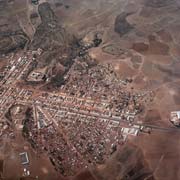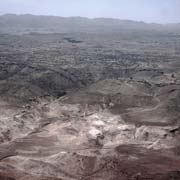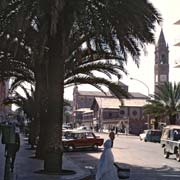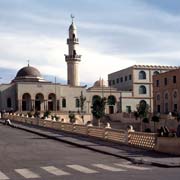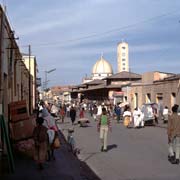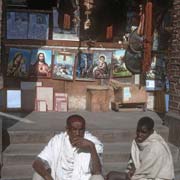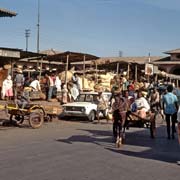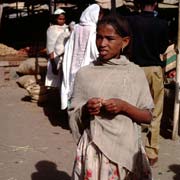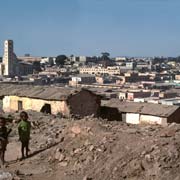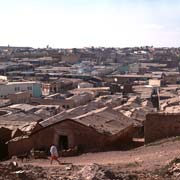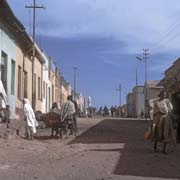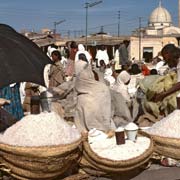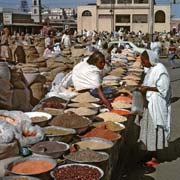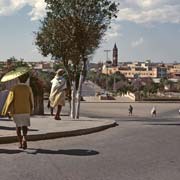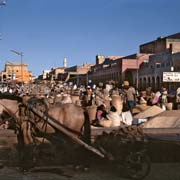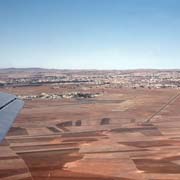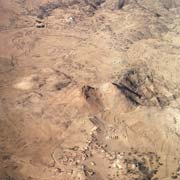Photos of Asmara, Eritrea’s capital, Eritrea
Asmara, Eritrea’s capital
Eritrea, a former province of Ethiopia, voted for its independence in 1993 after 30 years of civil war, becoming the first nation to split successfully from an independent African country. It borders on the Red Sea in the east, Sudan in the west and north, and Ethiopia in the south. It is a mountainous country; its highest point is 2,591 metres, located south of Asmara. Because of its location in the easternmost part of the Sahel, the country experiences periodic drought.
you may then send it as a postcard if you wish.
About half of Eritrea’s predominantly mainly highlander Tigre population are Ethiopian Orthodox Christians, and around half (mainly lowlanders) are Muslims. The dominant language is Tigrinya, a Semitic language related to Amharic (as spoken in Ethiopia) and written in Amharic script. Other major languages include Afar, Beni Amer and Arabic. Most highlanders grow sorghum, cotton, teff (a local grain), and citrus fruits, while many lowlanders continue to be nomadic herders of camels and goats. Salt from the Danakil Depression is a significant export. The government is seeking foreign aid and private investment to rebuild the devastated infrastructure after the civil war and develop tourism, fishing, and other industries.
Eritrea was part of the Aksum (Axum) empire established in the 1st century CE. In the 4th century CE, the highlanders converted to Christianity, and Islam spread in the lowlands beginning in the 7th century. Over the centuries, Eritrea’s strategic location on trade routes between the Nile River valley, the Red Sea, and central Ethiopia made it the object of numerous invasions by external powers seeking to control trade along the coast and in the interior - including the Ottoman Turks in the 16th century and Egypt in the 19th century. Eritrea was an Italian colony from 1890 to 1941: a province of Italian East Africa (Eritrea, Ethiopia, and Italian Somaliland) from 1936 until Italy’s defeat in the Second World War. From 1941 to 1952, when the United Nations agreed to federate Eritrea with Ethiopia under an arrangement in which Eritrea retained control over local affairs, Britain administered Eritrea.
In 1962, however, Ethiopia forcibly annexed Eritrea, and the Eritrean Liberation Front (ELF) began an armed secessionist struggle in the western lowlands. After the overthrow of Ethiopian emperor Haile Selassie in 1974, the independence movement gathered momentum under the leadership of the highlander-dominated Eritrean People’s Liberation Front (EPLF). As many as 100,000 Eritreans died during the long struggle, while another 750,000 fled. In May 1991, the Ethiopian government led by Mengistu Haile Mariam collapsed, and the EPLF assumed de facto control of Eritrea. The new Ethiopian rebel coalition government agreed to allow an Eritrean referendum on independence in exchange for guaranteed Ethiopian access to Mitsiwa (Massawa) port on the Red Sea. In the UN-supervised referendum of April 1993, more than 99% of Eritrean voters chose independence. It was formally declared on 24 May 1993 with Issayas Afewerki, the head of the EPLF and the provisional government established in 1991, elected as the first president.
Following Eritrea’s independence, Eritrea and Ethiopia disagreed about the exact demarcation of their borders. In May 1998, border clashes broke out that escalated into total warfare in which 80,000 people were killed. The war ended in a stalemate, and both sides signed a formal peace agreement in December 2000. Afewerki’s regime has since become a vicious dictatorship, ruling through fear, causing thousands of its terrified citizens to become refugees fleeing to Europe. According to Human Rights Watch, the government’s human rights record is considered among the worst in the world. In 2014 Reporters Without Borders ranked the media environment in Eritrea at the very bottom of a list of 178 countries, just below North Korea.
Eritrea’s capital city of Asmara, or Asmera (“The four made them united”) in the Tigrinya language, was developed mainly as an Italian built city. However, its origins go back about 700 years. It is 2,325 metres above sea level and has a population of almost 650,000 people. They are mainly Tigrinya (77%) and Tigre (15%). The main religions are the Eritrean Orthodox Tewahdo Church (40%), Catholicism (35%) and Sunni Islam (25%), with their principal places of worship being the Kidane Meheret Church, St Joseph’s Cathedral and the Al Khulafa Al Rashiudin Mosque. These photos date from 1973, when Eritrea was still an Ethiopian province.



